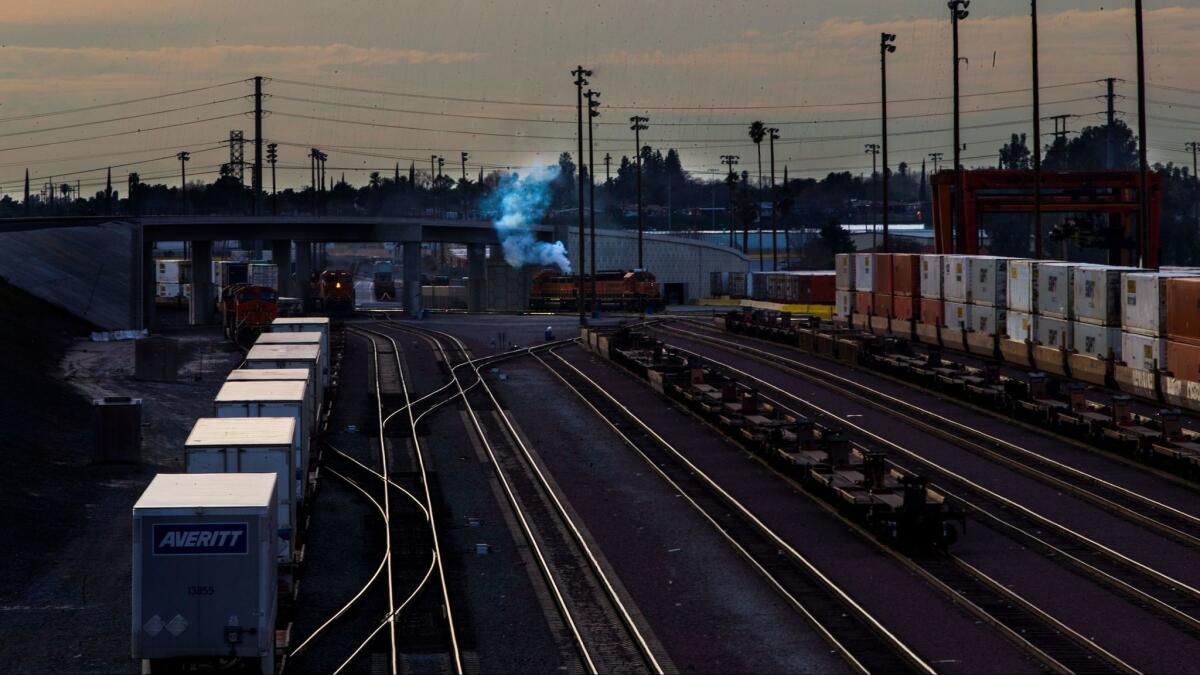Air board hears proposals to toughen smog-reduction plan but delays action

Southern California air quality regulators delayed action on a major smog-reduction plan Friday after hours of public testimony and debate about what steps should be taken to curb the nationâs worst air pollution over the next 15 years.
The South Coast Air Quality Management District board voted 9-3 to postpone consideration of the plan until its March 3 meeting. The decision came after Clark E. Parker Sr., a Democrat on the politically divided 13-member panel, left unexpectedly to attend a relativeâs funeral.
The delay gives environmentalists, industry and pollution regulators another month to wrangle over the details of the plan, which will guide efforts to slash harmful emissions and reduce harm to the health of millions across Los Angeles, Orange, Riverside and San Bernardino counties.
Generating the most debate was the planâs voluntary approach to ports, warehouses, rail yards and other hubs of the economically important but highly polluting goods-movement sector. The air district would first seek collaboration with the industry but may switch tactics and begin seeking formal rules within a year if the freight centers fail to agree to adequate and enforceable measures.
During testimony, environmentalists and residents from some of the worst-polluted communities criticized the districtâs approach to freight-handling facilities as weak and called for tougher measures to protect their health.
âWe canât have any more children, or people or our community hurting from the health impacts of this pollution,â said Marina BarragĂĄn, a Sierra Club organizer who held a photo of her 4-year-old nephew at the hospital for an asthma attack.
Business leaders and representatives of the ports, railroads, trucking and logistics industries, meanwhile, pressed officials to adopt the plan without changes, arguing that formal regulation would stifle growth in a sector that supports hundreds of thousands of jobs.
Saying at the hearing that the plan âfalls short,â air quality board member Sheila Kuehl, a Los Angeles County supervisor and Democrat, proposed changing it to require the adoption of regulations for ports, warehouse distribution centers and airports within two years if voluntary measures do not work.
Cargo-handling industries and the ports of Los Angeles and Long Beach strongly oppose such âindirect source rules,â which the air district has long considered to target emissions from ports and other goods-movement facilities where large numbers of trucks, ships and trains pick up and drop off cargo.
Lake Forest City Councilman Dwight Robinson, a Republican air quality board member who operates a business in and around the port complex, spoke against such changes to a plan that he said balances âenvironmental stewardship with blue-collar job retention.â
Robinson expressed concerns that imposing rules on the ports could provoke lawsuits. âWe could potentially grind our progress to a halt while we end up in court,â he said.
Jim Stewart, an environmentalist from West Long Beach near the port complex, told board members to take tougher action to âease the pain and suffering that is happening in this sacrifice zone.â
âVoluntary measures are not enough,â he said. âWe need a guarantee.â
Tracy Hernandez, chief executive of the Los Angeles County Business Federation, supported the plan as drafted but warned that if the air district âembarks on a path towards draconian regulations such as indirect source rules, then we are out.â
Though Southern California air quality has improved dramatically due to decades of rule-tightening, the region still does not meet a series of federal standards for ozone, the lung-damaging pollutant in smog that reaches the nationâs highest levels in the regionâs inland mountains and valleys. Steep emissions cuts from heavy-duty trucks, trains and other transportation-related sources are crucial to meet the Clean Air Actâs deadlines because they release the bulk of the pollution in the basin.
The air districtâs plan aims to go beyond existing regulations to slash smog-forming gases called nitrogen oxides by another 55% by 2031. Doing so will cost $16 billion, according to the agency. And success would hinge on finding ways to increase spending on clean-air incentive programs that deploy cleaner vehicles and equipment tenfold, to $1 billion a year.
But the district says costs to industry, taxpayers and consumers are vastly outweighed by the health benefits of cleaner air through the avoidance of thousands of asthma-related emergency room visits, missed school days and early deaths.
Another change to the plan proposed Friday by Rolling Hills Estates Councilwoman Judith Mitchell, a Democrat on the air board, would accelerate reductions under the districtâs troubled pollution-trading program, then replace the cap-and-trade program with traditional regulations.
The oil industry favors keeping the decades-old Regional Clean Air Incentives Market, or RECLAIM, which governs emissions of smog-forming nitrogen oxides from 275 of the regionâs largest stationary facilities. But the program has come under fire from state officials and environmentalists for failing to deliver promised emissions cuts and allowing refineries to avoid installing controls.
More to Read
Sign up for Essential California
The most important California stories and recommendations in your inbox every morning.
You may occasionally receive promotional content from the Los Angeles Times.











